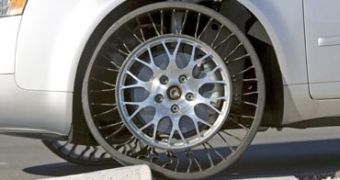If you ever had a flat tire in the middle of nowhere, no spare and waited for more than two hours for someone to come and rescue you, then you might consider throwing the car's wheels right to the garbage container and buy yourself a pair of tweels. Unless you want to be a wise guy and buy an additional spare tire, just in case the other one is already flat.
Tweels represent a type of non-pneumatic tires, meaning that they do not use air to support the weight of the car. Michelin was the first to announce that it had developed a revolutionary new wheel design back in 2005. The word itself is a combination between the words 'tire' and 'wheel'.
Because non-pneumatic tires don't use air to support the weight of the car, they cannot be punctured or become flat in order to bring the car to a complete halt. The prototype of the tweel involves using a set of spokes made out of polyurethane material that support an outer rim on which the running tread is placed. Between the spokes and the tire hub, there is a matrix of deformable plastic structures which flex under the load and return to their original form afterwards. Unlike traditional airless tires which use non-flexible materials in the wheel design, the tweel gets its equivalent of air suspension from the polyurethane spokes, which are flexible and temporarily deformable.
This special characteristic gives the tweel the capability of providing a more comfortable ride and increased vehicle handling. The disadvantage is that, once manufactured, the tweel cannot be adjusted to customer specification. The flexible spokes also provide a better lateral stiffness and lower rolling resistance, which ultimately translates into an economy in fuel.
Nevertheless, you might have also observed that tweels are not currently used to equip vehicles on the road. This is because, at the time, the prototype build by Michelin experiences excess vibration and noise while running at high speeds. Once these problems are resolved, Michelin will go to the mass production phase. Meanwhile, tweels are only used in vehicles that run at low speeds and have relatively low weights, such as wheelchairs, motorbikes and some construction equipment.
Eventually, improvements in design will make the tweel outperform the traditional pneumatic wheel. Michelin has planned all the design flaws to be corrected by the year 2016, so that it may appear in future car models.

 14 DAY TRIAL //
14 DAY TRIAL //